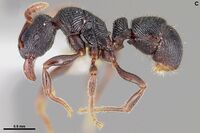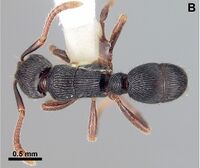Holcoponera avus
| Holcoponera avus | |
|---|---|

| |
| Scientific classification | |
| Kingdom: | Animalia |
| Phylum: | Arthropoda |
| Class: | Insecta |
| Order: | Hymenoptera |
| Family: | Formicidae |
| Subfamily: | Ectatomminae |
| Tribe: | Ectatommini |
| Genus: | Holcoponera |
| Species: | H. avus |
| Binomial name | |
| Holcoponera avus (Camacho, Franco & Feitosa, 2020) | |
Specimens of this species were collected in litter samples from primary montane forest, suggesting this species likely lives and/or forages in the leaflitter. It is only found at the type locality, which might indicate a preference for montane, preserved forest areas.
Identification
Camacho et al. (2020) - Size comparatively small (TL 2.57−2.75). Mandible smooth and shiny on their dorsal face. Small eyes, with five ommatidia on their largest diameter. Scape surpassing vertex margin at least by the same length as its apical width. Dorsal profile of mesosoma flat, metanotal impression absent. Propodeal spiracle positioned at the propodeum lateral margins, turned posteriorly and forming a tubuliform projection, its opening above the level of integument. Propodeum without any lobes, in lateral view. Metacoxal spine present. Segments I and II of gaster completely costulate.
Holcoponera avus is similar to Holcoponera mina. Holcoponera avus has compound eyes (only one ommatidium in H. mina), the scape surpasses the vertex margin (not reaching the vertex margin in H. mina), and the propodeal spiracle is protruding (less protruding in H. mina). Despite the morphological similarities between H. mina and H. avus, both species do not appear to be closely related, according to phylogenomic analysis of Holcoponera species relationships (Camacho et al., in prep).
Keys including this Species
Distribution
Distribution based on Regional Taxon Lists
Neotropical Region: Guyana (type locality).
Known only from the type locality, Mt. Ayanganna, Guyana.
Distribution based on AntMaps
Distribution based on AntWeb specimens
Check data from AntWeb
Countries Occupied
| Number of countries occupied by this species based on AntWiki Regional Taxon Lists. In general, fewer countries occupied indicates a narrower range, while more countries indicates a more widespread species. |

|
Biology
Castes
Nomenclature
The following information is derived from Barry Bolton's Online Catalogue of the Ants of the World.
- avus. Gnamptogenys avus Camacho, et al. 2020: 462, fig. 16 (w.) GUYANA.
- Type-material: holotype worker, 1 paratype worker.
- Type-locality: holotype Guyana: Mt Ayanganna, 1300 m., 5°22.483’N, 59°57.969’W, 13.x.2002, cloud forest, litter sample (T. Schultz, J. LaPolla, C. Marshall & R. Williams); paratype Mt Ayanganna Falls Camp, 1134 m., 5°22.332’N, 59°57.563’W, 11.x.2002, primary forest, litter sample (T. Schultz, J. LaPolla, C. Marshall & R. Williams).
- Type-depositories: CSBD (holotype); USNM (paratype).
- Combination in Holcoponera: Camacho, Franco, Branstetter, et al. 2022: 11.
- Status as species: Camacho, Franco, Branstetter, et al. 2022: 11.
- Distribution: Guyana.
Unless otherwise noted the text for the remainder of this section is reported from the publication that includes the original description.
Description
Worker
HL 0.60–0.62; HW 0.47–0.50; ML 0.24–0.27; SL 0.45–0.50; EL 0.1–0.08; WL 0.91–0.83; PL 0.25– 0.23; GL 0.84–0.80; TL 2.57–2.75; CI 78.33–80.64; SI 95.74−100; OI 21.27−16 (n=2).
Small size. Brown-coppery color, with appendages and gaster the same color. Body predominantly covered by thin, long, suberect hairs. Mandible smooth and shiny, without rugulae or striations on the dorsal surface. Head dorsum covered by long longitudinal costulae, deep and slightly irregular, semiparallel from the anterior margin of clypeus to vertex margin; vertex smooth and shiny, without hairs; surface of costulae covered by punctuation, giving them a rough appearance; intervals between costulae smooth and shiny. Mesosoma completely covered by wide costulae, approximately 0.035 mm in width, with straight margins on the dorsal surface; pronotum with transverse costulae anteriorly and several subparallel costulae on the dorsal surface. Declivitous face of propodeum covered by costulae, the same width and appearance as on mesosoma. Petiole with same sculpture as mesosoma. Coxae always covered by transverse costulae, narrower than on mesosoma. Segments I and II of gaster with same sculpture as mesosoma. Anterior face of first gastral segment bare, smooth with sparse rugulae.
Mandible triangular. Anterior margin of clypeus strongly convex in frontal view. Lateral margins of head straight and subparallel, slightly tapered anteriorly. Occipital corners extend ventrally, forming a small ridge. Antennal scape narrow, almost twice as wide apically than at its base; scape surpassing the vertex margin by the length of the apical width of scape. Eyes with at least five ommatidia, located slightly behind the anterior half of the head in frontal view. Vertex margin straight. Dorsal profile of mesosoma compact and flat in lateral view, without mesonotal impression. Lateral margins of declivitous face of propodeum parallel; dorsal and declivitous face of propodeum differentiated, forming a light ridge between the two; propodeal spiracle positioned at the propodeum lateral margins, turned posteriorly and forming a tubuliform projection, its opening above the level of integument. Propodeum without lobes or projections. Metacoxal spine acute and relatively large. Anterior and posterior margins of petiole subparallel in lateral view; petiole not pedunculated. Subpetiolar process predominantly opaque and subquadrate, very large, occupying more than half of the ventral surface of the petiole; subpetiolar process with a fenestra positioned centrally. Prora large and visible in lateral view.
Type Material
- Holotype, worker, Mt. Ayanganna cloud forest, 1300 m, Guyana, 5°22.483′N 59°57.969′W / 5.374717°N 59.96615°W, 13 October 2002, T. Schultz, J. LaPolla, C. Marshall, R. Williams, USNM00413910, Centre for the Study of Biological Diversity; cloud forest, litter sample.
- Paratype, 1 worker, Mt. Ayanganna Falls Camp, 1134 m, Guyana, 5°22.332′N 59°57.563′W / 5.3722°N 59.959383°W, 11 October 2002, T. Schultz, J. LaPolla, C. Marshall, R. Williams, USNM00413360, National Museum of Natural History; 1° forest, litter sample.
Etymology
From Latin avus=ancestor/grandfather, in reference to the species basal position within its clade, according to phylogenomic data. Fittingly, the name also honors the first author’s grandfather, whose love for nature was always a source of admiration and inspiration. The name is applied here as a noun in apposition.
References
- Camacho, G.P., Franco, W., Branstetter, M.G., Pie, M.R., Longino, J.T., Schultz, T.R., Feitosa, R.M. 2022. UCE phylogenomics resolves major relationships among Ectaheteromorph ants (Hymenoptera: Formicidae: Ectatomminae, Heteroponerinae): A new classification for the subfamilies and the description of a new genus. Insect Systematics and Diversity 6(1): 5; 1–20 (doi:10.1093/isd/ixab026).
- Camacho, G.P., Franco, W., Feitosa, R.M. 2020. Additions to the taxonomy of Gnamptogenys Roger (Hymenoptera: Formicidae: Ectatomminae) with an updated key to the New World species. Zootaxa 4747: 450 476. doi:10.11646/zootaxa.4747.3.2

